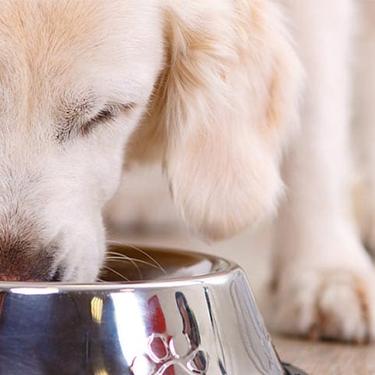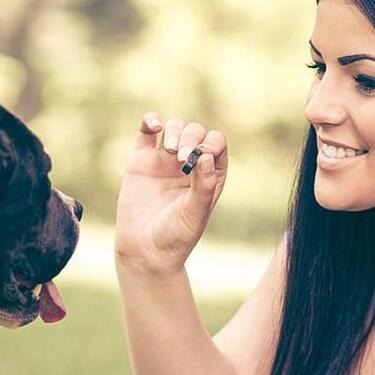
-
Find the right food for your pet
Take this quiz to see which food may be the best for your furry friend.
Find the right food for your pet
Take this quiz to see which food may be the best for your furry friend.
Featured products
 Adult 7+ Perfect Digestion Chicken, Whole Oats & Brown Rice Recipe Dog Food
Adult 7+ Perfect Digestion Chicken, Whole Oats & Brown Rice Recipe Dog FoodScience Diet's breakthrough nutrition supports ultimate digestive well-being & healthy microbiome for dogs age 7+
Shop Now Adult Healthy Cuisine Roasted Chicken, Carrots & Spinach Stew Dog Food
Adult Healthy Cuisine Roasted Chicken, Carrots & Spinach Stew Dog FoodDelicious roasted chicken paired with tender vegetables in a succulent stew
Shop Now Small & Mini Savory Stew with Chicken & Vegetables Dog Food
Small & Mini Savory Stew with Chicken & Vegetables Dog FoodA delicious complement to the nutrition of Science Diet Small & Mini 7+ dog food
Shop NowFeatured products
 Adult Savory Entrée Can Variety Pack Cat Food
Adult Savory Entrée Can Variety Pack Cat FoodPrecisely balanced nutrition with the delicious taste of savory minced chicken to help fuel the energy needs of cats during the prime of their life
Shop Now Adult 7+ Senior Vitality Chicken & Vegetable Stew Cat Food
Adult 7+ Senior Vitality Chicken & Vegetable Stew Cat FoodImproves Everyday Ability to Get Up & Go
Shop Now Adult 7+ Tender Tuna Dinner Cat Food
Adult 7+ Tender Tuna Dinner Cat FoodWith delicious chunks in a decadent gravy
Shop Now -
Dog
- Dog Tips & Articles
-
Health Category
- Weight
- Food & Environmental Sensitivities
- Urinary
- Digestive
- Joint
- Kidney
-
Life Stage
- Puppy Nutrition
- Adult Nutrition
- Senior Nutrition
Cat
- Cat Tips & Articles
-
Health Category
- Weight
- Skin & Food Sensitivities
- Urinary
- Digestive
- Kidney
-
Life Stage
- Kitten Nutrition
- Adult Nutrition
Featured articles
 Do Dogs and Cats have Belly Buttons?
Do Dogs and Cats have Belly Buttons?Learn whether cats & dogs have belly buttons like humans, what the function is, and if there are any health concerns associated with it.
Read More Why Are Dogs and Cats So Cute?
Why Are Dogs and Cats So Cute?If waggy puppy dog tails and furry kitten yawns make you swoon, you're not alone. Why are cats so cute? And, dogs too! Let's find out!
Read More Does My Pet Hate Me?
Does My Pet Hate Me?Learn tips for bonding with your pet if you've ever thought, 'My dog doesn't like me, or 'Why do I have a standoffish cat?'
Read More -


As a dog parent, you may have heard of a disease called distemper after speaking with your veterinarian. But what is distemper? And is it preventable? Knowing the basics about distemper, such as what distemper symptoms in dogs look like and when to seek medical attention, can help to keep your pup safe from this common disease.
What Is Distemper?
In dogs and other mammals, distemper is a contagious and sometimes fatal viral disease. The name of the disease comes from the virus that causes the problem: canine distemper virus (CDV). CDV is closely related to the measles virus in humans. The distemper virus affects several different carnivorous mammals and it's very common in raccoons, skunks and foxes. It's also been seen in hyenas, weasels, badgers, otters, ferrets, mink, wolverines and big cats in zoos. Most carnivorous mammals can be infected with some form of the distemper virus, and distemper itself is considered to be a global disease.
Distemper can be transmitted to your pup in a few different ways — via airborne exposure when droplets from an infected animal's nose contaminate their environment, through direct exposure with an infected animal or in utero through the placenta.
Distemper Symptoms in Dogs
Distemper can affect many parts of a dog's body, but it usually impacts the respiratory, gastrointestinal and neurological systems. Additional areas that can be affected by distemper include the eyes, genitals, teeth, paw pad and nose skin, and endocrine (glands), urinary and immune systems.
Young dogs are much more susceptible to distemper than adult dogs. The first sign of distemper is usually a fever accompanied by discharge from the nose and eyes. Dogs with distemper often have very low energy and won't want to eat. Usually, these symptoms are followed by effects on a dog's gastrointestinal tract, respiratory tract or nervous system, which can include:

- Diarrhea
- Seizures and/or muscle tremors
- Circling and/or head tilts
- Drooling
- Loss of coordination
- Weakness or paralysis
- Blindness from inflammation inside the eye and optic nerve
- Coughing due to pneumonia
- Hardened skin on the paw pads and nose
- Loss of enamel on teeth (seen in dogs who've recovered from distemper)
Distemper weakens a dog's immune system, making them more susceptible to secondary bacterial infections. More than half of the dogs who contract distemper will not recover, according to "Blackwell's Five-Minute Veterinary Consult: Canine and Feline," with many of them passing away two to four weeks after contracting the virus, usually due to neurological problems.
Dogs who do recover from distemper are not considered to be carriers of the disease. In rare cases, dogs who recover from distemper can have a relapse of central nervous system symptoms two to three months after their initial infection, which may be fatal.
Diagnosing Distemper in Dogs
To diagnose distemper in dogs, your veterinarian will consider your pup's health history, vaccination history, as well as any physical exam findings. Because distemper is incredibly common and contagious, any young pup who show symptoms and hasn't been vaccinated will be considered potentially infected. In these scenarios, precautions will need to be taken to isolate your pup.
The signs of distemper in dogs can mimic those of several other infectious diseases, including parvovirus, kennel cough and meningitis. If you suspect that your dog may be infected, you'll want to take them to the vet right away. To confirm a diagnosis, your vet will likely recommend a series of lab tests, including blood chemistry, complete blood count, fecal exams for parasites and parvovirus testing. They may also recommend additional distemper-specific blood tests. If they suspect pneumonia, your vet may recommend chest radiographs for your pup, too.


Tasty Tips

Treatment for Distemper
Your dog should be admitted to a veterinary hospital for isolation and treatment if they've been diagnosed with distemper or if you suspect they may have it. To prevent the spread of the disease in the hospital, it's important that dogs with distemper are isolated from others and only handled by people wearing personal protective equipment. But what is distemper treatment for pups, usually?
Currently, there is no anti-viral drug available for CDV. Since dogs with distemper typically don't want to eat and drink, become dehydrated from diarrhea and are susceptible to secondary bacterial infections, treatment is focused on supportive care. This may include fluid therapy, antibiotics and cleaning away nasal and eye discharge. Once their fever subsides and any secondary infections are controlled, dogs usually regain their appetite.
Recovery from distemper depends on a myriad of factors, including your pup's overall health and the severity of their nervous system symptoms. Severe symptoms like seizures are usually associated with a lower chance of recovery. Dogs who recover don't carry the distemper virus and aren't considered infectious.
Preventing Distemper
Fortunately, a highly effective modified live vaccine exists to prevent distemper in dogs, which is considered a core vaccine for puppies. It's recommended that all puppies 6 weeks old and older receive three to four distemper vaccine boosters every two to four weeks until they're 16 weeks old.
Most puppies are protected from distemper when they're born, thanks to the powerful antibodies they receive from their mother's milk. However, these maternal antibodies wear off as the puppy grows, leaving them vulnerable to infection. These antibodies also interfere with the vaccine, which is why a pup will need multiple boosters to appropriately develop vaccine antibodies.
Distemper is a serious disease, but it doesn't have to affect your precious pup's health. By following your veterinarian's vaccine recommendations and heeding the tell-tale signs mentioned above, you can easily protect your dog from distemper.


Dr. Sarah Wooten graduated from UC Davis School of Veterinary Medicine in 2002. A member of the American Society of Veterinary Journalists, Dr. Wooten divides her professional time between small animal practice in Greeley, Colorado, public speaking on associate issues, leadership, and client communication, and writing. She enjoys camping with her family, skiing, SCUBA, and participating in triathlons.
Related products
Related articles

Learn about choosing the right dog food to help ensure your adult dog will receive the correct balance of nutrition.

Learn the the dangers of feeding your dog chocolate, which types are most dangerous, and what to do if you discover that they have consumed chocolate.

Learn how today's wet dog food blends have gotten a face lift, and how you'll provide your dog the nutrition he needs in the form he loves.

Proper nutrition for your pregnant or nursing dog is vital to her and her puppy's health. Learn what you should do provide her with the proper nutrients.

Put your dog on a diet without them knowing
Our low calorie formula helps you control your dog's weight. It's packed with high-quality protein for building lean muscles, and made with purposeful ingredients for a flavorful, nutritious meal. Clinically proven antioxidants, Vitamin C+E, help promote a healthy immune system.
Put your dog on a diet without them knowing
Our low calorie formula helps you control your dog's weight. It's packed with high-quality protein for building lean muscles, and made with purposeful ingredients for a flavorful, nutritious meal. Clinically proven antioxidants, Vitamin C+E, help promote a healthy immune system.

